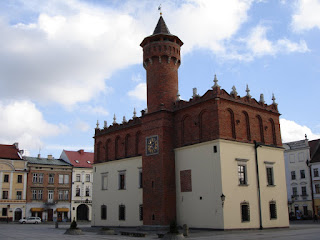 Zamosc Town Hall
Zamosc Town HallEvery time I try to pronounce this city name, Poles don’t understand what I’m saying and I have to write it down. When they say, “Oh…ZAM-ootshch” I think, yeah, like I said! But apparently I don’t get it close enough to recognize. I had first read about Zamosc in Mitchner’s book Poland last summer, where the town square was described as being similar to that of Siena, Italy. Having been to Siena with my book club, I thought it would be fun to check it out. The tour books confirmed that Zamosc is “one of the best-preserved Renaissance towns in Europe.” It was planned and built from scratch in the 1500s according to Italian concepts of the ideal town by Jan Zamoyski, one of the powerful Polish magnates. A program of restoration began in the 1970s and the town has been declared a UNESCO World Heritage Site.
So we took a mini-bus to Zamosc – about 95 kilometers southeast of Lublin. (These mini-busses are great little entrepreneurial businesses. In every city we’ve been to, a fleet of vans has set up shop near the government-run bus station. They run very cheap, regular service to the most popular destinations. While some of them cram in a few too many seats and are more than willing to take stand-up passengers…and they do tend to drive a little fast…and the shocks aren’t all that good…they are a great mode of transportation for those of us who don’t want to venture driving on our own on the Polish roads.) Still cold and snowy, we found our way to the old town square - which was practically deserted, though the buildings are very beautiful. I’m sure in the summer when the square is filled with cafes it’s a delightful little day tour.
Zamosc Town Square
However, we quickly realized that on a cold day in November there wasn’t much to do or see and decided to return to Krakow. We found the Tourist Information Center on the square quite by accident (not being where it was listed on my tour book) as we were looking for a café, and fortunately it was open on a Saturday morning, even though we were the only tourists anywhere to be seen. The nice lady there said she didn’t speak English, but she did well enough to inform us that there was only one train and one bus scheduled to go from Zamosc to Krakow each day and that they had both already left. She checked the mini-bus schedule for us and found out there weren't any that go to Krakow on Saturdays (it would have been quite a long ride in a mini-bus anyway). We really didn’t want to spend the night here, so she kept checking various alternatives and finally came up with a bus to Jarislow (yar-EES-waf), a small town in the middle of nowhere, that left in 4 hours. With a 30-minute layover, she assured us we could walk the short distance to the Jarislow train station and purchase a ticket to Krakow that would get us home around 11 p.m. John was very skeptical.

Ruins of Zamosc' Old City WallsWithout any alternative, we set out on our snowy, foggy ride through the desolate countryside. We were glad our bus driver was very cautious, since the roads were winding and narrow with no shoulders (it gets dark at 3 p.m. here, which added to the feeling of being out in the middle of nowhere). The landscape was gorgeous when we could see it in the lights of the bus with snow on every twig and branch of every tree and shrub – often with the tree branches meeting over the road. One tour book describes this area as “the least populated and least known part of Poland: a great swath of agricultural plains punctuated by remote, backwoods villages and a few market towns.” None of this helped with John’s sense that we would be stranded once reaching this place called Jarislow. However, we made it there on schedule, made the switch to the train in plenty of time, managed to get on the right train even without any signage anywhere in the station, and then settled in for the several-hour ride to Krakow. Returned to snow on the ground here as well. Winter has arrived. (Though we didn’t see much of it, turns out Jarislow is one of the oldest towns in the country and on the main road east to the Ukraine. It has a history as a trading town going back to the 12th century.)
Once back in the apartment, I read a little more about Zamosc: “Chiefly due to its off-the-beaten-track location, the town has neither assumed the prominence it deserves on the tourist trail, nor seen the sort of economic success that has revitalized Lublin. Early in the 19th century Zamosc had sunk so far that even the Zamoyskis themselves moved on!” But if we hadn’t made the trip, I would always have wondered what it was like. John says he doesn’t regret going either….we just have to do a little better job of contingency planning next time – and there’s nothing we can do about the weather, so we don’t want to let it stop us from seeing places we’ll probably never have a chance to visit again. (And, though the main square was beautiful, I didn't really see the resemblance to Siena.)

 Laurel, James and Claire on the walkway up to the Wawel Castle
Laurel, James and Claire on the walkway up to the Wawel Castle Some of the spires and domes of the Wawel Cathedral.
Some of the spires and domes of the Wawel Cathedral. Zamosc Town Hall
Zamosc Town Hall

 Kazimierz Dolny castle ruins
Kazimierz Dolny castle ruins




 Collegium Maius Courtyard
Collegium Maius Courtyard

 Sts. Peter and Paul Church
Sts. Peter and Paul Church











